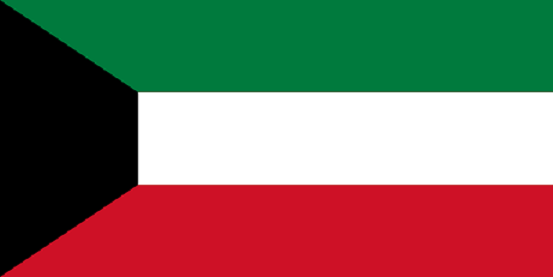
Geography

Source: This image is the intellectual property of TUBS. Redistribution under licence CC BY-SA 3.0
Area: 17,818 km2 (0% water)
Coastline: 499 km
Terrain: mostly flat and barren desert
Highest point: Mutla Ridge 306 m (along the coast; west of Kuwait Bay)
Climate: dry desert; hot summers; short, cool winters
Geographical population distribution: About 65% of the population is concentrated in four small governorates south of Kuwait Bay
Natural resources: petroleum, fish, shrimp, natural gas
Demographics
Population: ~5,026,000 (2025 est.)
Annual population growth: ~1.98 % (2024 est.)
Estimated population in 2025: ~5,026,000
Age structure (2024):
0–14 years – ~19.5 %
15–64 years – ~76.7 %
65+ years – ~3.8 %
Total fertility rate: ~2.24 children per woman (2022 est.)
Birth rate: ~17.8 per 1,000 people (2022 est.)
Death rate: ~2.25 per 1,000 people (2022 est.)
Median age: ~32.9 years (2025 est.)
Life expectancy at birth: ~80.8 years (2025 est.)
Males – ~77.7 years
Females – ~80.6 years
Net migration rate: ~−3.87 migrants per 1,000 population (2022 est.)
Languages: Arabic (official), English widely used, minority languages: Hindi, Tagalog, Persian, Urdu, etc.
Religious groups: Muslim ~74.6 %, Christian ~18.2 %, Others/Unspecified ~7.2 %
Ethnic groups: Kuwaiti nationals ~38–42 %, expatriates ~58–62 %
Economy
GDP: $105.96 bil (2020)
GDP per capita: $24,811.8 (2020)
GDP annual growth rate: -8.7% (2020)
Public debt (% GDP): 15.24% (2019)
Inflation (CPI): 2.1% (2020)
Unemployment: 6.8% (2020) Imports: $33.5 bil (2019)5 largest import partners (% total imports - 2019): China 17.86%, United States 9.10%, Arab United Emirates 8.41%, Japan 6.30%, Saudi Arabia 6.19%
Exports: $64.5 bil (2019)5 largest export partners (% total exports - 2019): Unspecified 90.99%, Iraq 1.49%, China 1.41%, India 1.25%, Saudi Arabia 1.02%,
Defence expenditure (% GDP): 5.1% (2018)
Global Competitiveness Report (World Economic Forum)65.1/100 (2019 – position 46/141)
Index of Economic Freedom (Heritage Foundation)64.1/100 (2021 – position 74/180)
Income Inequality Index (Gini – World Bank)-
Prosperity Index (Legatum Institute)60.08/100 (2021 – position 58/167)
Militay Power
Active personnel: 17,000
Army: 12,500
Navy: 2,000
Air Force: 2,500
National Guard:6,500 (2021)
Defence expenditure (%GPD): 6.5% (2020)Politics and Government
Form of government: Constitutional monarchy
Emir: Sheikh Meshal Al-Ahmad Al‑Jaber Al‑Sabah (since Dec 2023)
Prime Minister: Sheikh Ahmad Abdullah Al‑Ahmad Al‑Sabah (since May 15, 2024)
Executive branch: The Emir of Kuwait is the country’s head of state and exercises executive authority through his ministers, while the Prime Minister is the head of government and is appointed by the Emir. The rule of the country is hereditary in the family of Al-Sabah but the any new Emir chosen must be confirmed by the National Assembly. Members of the Council of Ministers are nominated by the Prime Minister and appointed by the Emir. Each minister may be entrusted with leading one or more ministries. The Emir has the final say in defence matters and no law can be passed without his consent.
Legislative branch: Legislative authority is vested in the Emir and the National Assembly. The National Assembly is unicameral body comprised of 65 members, of which 50 are elected for a 4-year term and 15 cabinet ministers who sit as ex officio members. Elected members of the National Assembly may also serve as ministers, in which case the number of ex officio members is reduced accordingly. The National Assembly debates policies and government programs, passes laws and may withdraw its confidence from any member of the Council of Ministers, except the Prime Minister.
Judicial branch: The judiciary is administered by the Supreme Judicial Council, which nominates judges who are then appointed by the Emir. Kuwait’s court system has three levels of courts: Courts of First Instance form the base of the system while Courts of Appeal serve as courts of appeal in the intermediate and final stages of litigation. The Court of Cassation is the state’s highest court and is divided into Commercial, Civil and Criminal Boards. Kuwait also has a Constitutional Court comprised of five judges selected by the Supreme Judicial Council and appointed by the Emir.
Parliamentary parties: Formally, no political parties exist but political blocs are formed within the National Assembly.
Last elections: Municipal elections 2018 – Turnout estimated at about 20% of 519,636 voters.Next elections: Parliamentary elections in December 2024
Rule of Law - Human Rights
Corruption Perceptions Index (Transparency International)42/100 (2020 - position 78/180)
Rule of Law Index (World Justice Project)
-
Global Terrorism Index (Institute for Economics & Peace)
2.487/10 (2019 – position 75/163)
Fragile States Index (Fund For Peace)
52.9/120 (2021 – position 129/179)
Democracy Index (Economist Intelligence Unit)
3.80/10 (2020 – position 114/167)
Press Freedom Index (Reporters Without Borders)
34.36/100 (2020 – position 105/180)
Freedom in the World Index (Freedom House)
37/100 (2021)
Sources
United Nations (UN – Population Division, UNdata, UNcomtrade), World Bank, Federal Reserve Economic Data (FRED – St. Louis Fed), Composition of Religious and Ethnic Group Project (CREG – Cline Center for Advanced Social Research, University of Illinois), Association of Religion Data Archives (ARDA), British Broadcasting Corporation (BBC), International Institute of Strategic Studies (IISS – Military Balance), New York University School of Law, Gulf Times, NationMasterSelected Articles
Al-Saif, Bader (2020), Another Invasion of Kuwait, Carnegie Middle East Center
Cafiero, Giorgio (2020), Kuwait’s Yemen foreign policy, Middle East Institute
Worldometer (2025), Kuwait population 2025 estimate, growth rate, fertility, life expectancy
Worldometer (2025), Kuwait demographics details 2025
PopulationPyramid.net (2025), Kuwait 2025 population pyramid, median age, dependency ratios
Gulf News (2024), Emir Sheikh Meshal installation and cabinet formation
Asharq Al-Awsat (2024), Kuwait forms first government under new Emir and Prime Minister
Reuters (2024), Kuwait names Ahmad Abdullah Al Ahmad Al Sabah as Prime Minister




